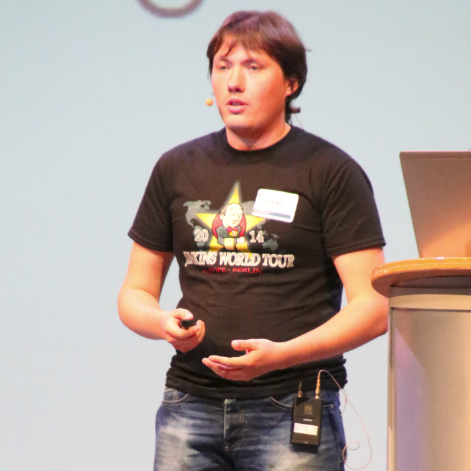#JUES 15 - Program
##Kohsuke Kawaguchi, CloudBees and Jenkins Creator
 Kohsuke Kawaguchi is a well-respected developer and popular speaker at industry and Jenkins community events. He’s often asked to speak about his experience and approach in creating Jenkins; a CI platform that has become a widely adopted and successful community-driven open source project. The principles behind the Jenkins community – extensibility, inclusiveness, low barriers to participation – have been the keys to its success. Kohsuke’s sensibilities in creating Jenkins and his deep understanding of how to translate its capabilities into usable software have also had a major impact on CloudBees’ strategy as a company.
Kohsuke Kawaguchi is a well-respected developer and popular speaker at industry and Jenkins community events. He’s often asked to speak about his experience and approach in creating Jenkins; a CI platform that has become a widely adopted and successful community-driven open source project. The principles behind the Jenkins community – extensibility, inclusiveness, low barriers to participation – have been the keys to its success. Kohsuke’s sensibilities in creating Jenkins and his deep understanding of how to translate its capabilities into usable software have also had a major impact on CloudBees’ strategy as a company.
Twitter: @kohsukekawa Blog: kohsuke.org
##Continuous Delivery in a Box
###Jan Sørensen,Praqma
 This presentation will demonstrate a one-click provisioning of infrastructure for a Continuous Delivery pipeline. The pipeline is Docker based, i.e. each service in the pipeline is implemented as a Docker image. The pipeline consists of typical Continuous Delivery services like Jenkins master, Jenkins slaves (provisioned on demand), Artifactory. The provisioning of Docker host is done with docker-machine, orchestration with docker-compose, and scaling with docker-swarm.
This presentation will demonstrate a one-click provisioning of infrastructure for a Continuous Delivery pipeline. The pipeline is Docker based, i.e. each service in the pipeline is implemented as a Docker image. The pipeline consists of typical Continuous Delivery services like Jenkins master, Jenkins slaves (provisioned on demand), Artifactory. The provisioning of Docker host is done with docker-machine, orchestration with docker-compose, and scaling with docker-swarm.
Continuous Deployment to the Device
###Mikkel Arentoft, SCAUT
 Mikkel Arentoft (M. Sc. in Computer Science) is principal consultant at Rehfeld and the lead architect of the Scaut. Mikkel has developed software professionally since 1998 and in a lot of areas such as monitoring, planning, GIS, traffic control, finance and health care. Mikkels primary area of interests are lean based software development and architecture Publishing.
Scaut is an interdisciplinary research and development project based in Copenhagen, Denmark. The project runs from 2014-2018 and aims to support collaboration of patients and clinicians around early detection of signs and symptoms. In this project, we develop an app that allows patients to take action on their condition from home and a clinical platform that uses advanced analytics to predict deterioration.
Mikkel Arentoft (M. Sc. in Computer Science) is principal consultant at Rehfeld and the lead architect of the Scaut. Mikkel has developed software professionally since 1998 and in a lot of areas such as monitoring, planning, GIS, traffic control, finance and health care. Mikkels primary area of interests are lean based software development and architecture Publishing.
Scaut is an interdisciplinary research and development project based in Copenhagen, Denmark. The project runs from 2014-2018 and aims to support collaboration of patients and clinicians around early detection of signs and symptoms. In this project, we develop an app that allows patients to take action on their condition from home and a clinical platform that uses advanced analytics to predict deterioration.
Web: rehfeld.dk Mail: mar@rehfeld.dk
##Version your build process as you version your code with Literate plugin
###Vincent Latombe, CloudBees
 Vincent is part of the Engineering team at CloudBees. Before that he managed a large Jenkins infrastructure at Amadeus. He likes building smart solutions with a focus on usability and user empowerment. He is the maintainer of the Clearcase plugin, and contributes to Jenkins core, Git and Literate plugins.
The Literate plugin allows a project to define its build process directly in a description file (Markdown or YAML supported). Project owners have control over their build process and can refactor it as they refactor their code, while reusing all of the Jenkins goodness. Meet this beautiful plugin and fall in love with it!
Vincent is part of the Engineering team at CloudBees. Before that he managed a large Jenkins infrastructure at Amadeus. He likes building smart solutions with a focus on usability and user empowerment. He is the maintainer of the Clearcase plugin, and contributes to Jenkins core, Git and Literate plugins.
The Literate plugin allows a project to define its build process directly in a description file (Markdown or YAML supported). Project owners have control over their build process and can refactor it as they refactor their code, while reusing all of the Jenkins goodness. Meet this beautiful plugin and fall in love with it!
Twitter: @Vlatombe
##How To Connect Your Slave
###Robert Sandell, CloudBees
 Robert recently joined CloudBees as a Jenkins developer, and before that he developed and maintained the Jenkins installations at Sony Mobile. He has been a Jenkins community member since 2010 and is maintainer of several plugins like the Gerrit Trigger and Build Failure Analyzer. Perhaps most importantly, he is an enjoyer of fine Calvados.
There are many plugins in Jenkins for connecting slaves in various ways. How do they work and is there anyone better than the other?
Robert recently joined CloudBees as a Jenkins developer, and before that he developed and maintained the Jenkins installations at Sony Mobile. He has been a Jenkins community member since 2010 and is maintainer of several plugins like the Gerrit Trigger and Build Failure Analyzer. Perhaps most importantly, he is an enjoyer of fine Calvados.
There are many plugins in Jenkins for connecting slaves in various ways. How do they work and is there anyone better than the other?
Twitter: @robert_sandell
##Configuration as code and JobDSL
###Niels Bech Nielsen, Logical
 Niels Bech Nielsen is a very experienced developer and architect, who likes working on the leading edge of software development. Probably more hardcore than you immediately think. Have amble team and technical leadership experiences, but also a very valuable expert in software technology and java in particular. Predominantly using agile methods such as scrum and kanban with focus on continuous delivery, but also experienced in other processes including RUP and waterfall. Have been teaching and mentoring and always offering skill boosts. Been used often to raise the bar of the development team.
Niels Bech Nielsen is a very experienced developer and architect, who likes working on the leading edge of software development. Probably more hardcore than you immediately think. Have amble team and technical leadership experiences, but also a very valuable expert in software technology and java in particular. Predominantly using agile methods such as scrum and kanban with focus on continuous delivery, but also experienced in other processes including RUP and waterfall. Have been teaching and mentoring and always offering skill boosts. Been used often to raise the bar of the development team.
Twitter: @nielsbech
##Test Driven Development in Excel
###Laurits Søgaard Nielsen, Visual Reporting
 Briefly speaking, we have developed a tool for Excel that allows Excel developers to: Put code sheets and Excel files in Git, develop VBA test driven and perform unit and acceptance tests on code and sheets. In addition, we have integrated all of this into Jenkins pipelines, which means that we can test 8 different Excel platforms in parallel and run static code analysis of the VBA code. All this reduces the number of errors that can happen when developing Excel - and documents the business rules of the business in tests.
Briefly speaking, we have developed a tool for Excel that allows Excel developers to: Put code sheets and Excel files in Git, develop VBA test driven and perform unit and acceptance tests on code and sheets. In addition, we have integrated all of this into Jenkins pipelines, which means that we can test 8 different Excel platforms in parallel and run static code analysis of the VBA code. All this reduces the number of errors that can happen when developing Excel - and documents the business rules of the business in tests.
LinkedIN: Laurits Søgaard Nielsen
##Continuous Delivery of Embedded Systems
###Mike Long, Partner Praqma Norway
 As a DevOps and Continuous Delivery consultant, Mike’s specialties include coaching and mentoring teams to adopt modern technical practices in hostile embedded and legacy environments. He holds over 10 years of professional software engineering experience, working in a variety of cultures and business domains. He considers software as a craft, and enjoys sharing the pursuit of technical excellence with fellow professionals.
As a DevOps and Continuous Delivery consultant, Mike’s specialties include coaching and mentoring teams to adopt modern technical practices in hostile embedded and legacy environments. He holds over 10 years of professional software engineering experience, working in a variety of cultures and business domains. He considers software as a craft, and enjoys sharing the pursuit of technical excellence with fellow professionals.
Continuous Delivery is all the rage, but many of the practices are not applied in the embedded world because the literature seems to focus on the web development community. That is a great shame, because there is a great deal we can apply on our embedded software development projects. This talk will show you how to apply some of the key techniques, such as embedded versioning and software traceability, embedded continuous delivery pipelines, acceptance testing with hardware, automatic deployment to hardware, continuous deployment. Beyond that, the talk will show some real-life examples of companies who are at the leading edge of this adoption.
Twitter: @meekrosoft Blog: meekrosoft
##Continuous Delivery CoDe. with Jenkins and Chef
###Alex Manly, Solutions Architect, Chef
 Alex Manly is a Solutions Architect for Chef Software, and previous to Chef, the Vice President of Product Development at MidVision. He designed and built the RapidDeploy product, which primarily is used for deployment automation of middleware systems.” Alex has previously spoken at the Jenkins User Conference in Boston, Berlin, and Copenhagen on the subject of automated application deployments.
Alex Manly is a Solutions Architect for Chef Software, and previous to Chef, the Vice President of Product Development at MidVision. He designed and built the RapidDeploy product, which primarily is used for deployment automation of middleware systems.” Alex has previously spoken at the Jenkins User Conference in Boston, Berlin, and Copenhagen on the subject of automated application deployments.
Delivery Truck is an open source project written by Chef which allows you to control the process for delivering Chef code in a well defined pipeline. In this talk you will learn about best practices to continuously deliver infrastructure code using Jenkins.
Twitter: @apmanly
##Xethrubot - Testing the Untestable with Jenkins
###Olav Liseth, Senior Development Manager, Xethru
 Since receiving his Masters from the University of Oslo Olav has been working as an Analog/Mixed-signal ASIC Engineer and participated in the research and development of today’s generation of Novelda radars. Today he utilizes his thorough knowledge of the core Novelda technology to develop unique radar sensor solutions.
Since receiving his Masters from the University of Oslo Olav has been working as an Analog/Mixed-signal ASIC Engineer and participated in the research and development of today’s generation of Novelda radars. Today he utilizes his thorough knowledge of the core Novelda technology to develop unique radar sensor solutions.
###Stig Støa, Senior Development Engineer, Xethru
 Stig received his Ph.D degree from the University of Oslo in 2012. While conducting his research on electromagnetic propagation in tissues and medical sensor networks, Stig joined the Novelda team in 2007.
Stig received his Ph.D degree from the University of Oslo in 2012. While conducting his research on electromagnetic propagation in tissues and medical sensor networks, Stig joined the Novelda team in 2007.
Together they are part of Noveldas SW and Applications team, a team that has evolved from a small group developing customized applications, to an agile team delivering advanced sensor systems.
Novelda is the company behind Xethru, a radical new radar technology that has applications in Healthcare, Emergency Response, Personal Wellness plus many more. We make everything from the silicon to the complex signal processing algorithms that analyze and interpret the data. As a startup, we rely on the rapid development and quality assurance that continuous delivery provides. But we had a challenge, how do we test the seemingly untestable? Radar technology relies on analog and digital hardware, embedded systems, real time signal processing and RF propagation. What would be a full system test? How can we control the environment? How do we simulate a baby breathing? How do we know when things go wrong?
Come to this talk to find out how we solved this testing challenge!
##Transforming Enterprise Release Management in Elastic Beanstalk using Jenkins, Docker and Jenkins Job Builder
###Yves Hwang, Internet & Mobility Architect, Statoil Fuel & Retail
 Yves is a full stack software craftsman with a passion for software architecture and product development. A developer at heart and working in Statoil Fuel & Retail as the Internet & Mobility Architect, Yves is opinionated about advocating devops culture that is open source, agile, test driven and peer reviewed. Yves codes daily and is no stranger to 3rd line support duties. A big fan of Docker and Ansible, he primarily programs in Java, Javascript and dabbles in a bit of C.
Yves is a full stack software craftsman with a passion for software architecture and product development. A developer at heart and working in Statoil Fuel & Retail as the Internet & Mobility Architect, Yves is opinionated about advocating devops culture that is open source, agile, test driven and peer reviewed. Yves codes daily and is no stranger to 3rd line support duties. A big fan of Docker and Ansible, he primarily programs in Java, Javascript and dabbles in a bit of C.
Releasing software is hard. Getting rid of bad habits under the guise of old school enterprise I.T. is even harder. This is a devOps story about transforming an enterprise and its dated methods of release management into something modern, scalable, reliable and state of the art. On a technical level, and at the heart of this transformation, lies Jenkins, Docker, and Jenkins Job Builder.
A number of our new microservices lives in Elastic Beanstalk in AWS. Coupled with bursty release cycles and multiple development teams, a need for a common build pipeline soon surfaced. Reliability and scalability is the shangri la of any build pipelines. The aforementioned toolchain allowed us to perform verification on the buildpipeline itself, template jobs for reusability, and most of all, deploy and track all changes to any Jenkins jobs via Git. This significantly sped up the process of configuring complex Jenkins jobs, and enabled highly parameterized build pipeline to take shape. Ultimately this allowed our teams to utilize Jenkins a lot more efficiently and to better manage Jenkins and the build pipeline overtime.
This presentation aims to share the findings, lessons, and the slightly macabre story that is enterprise I.T. and how we went about cleaning up this mess.
Twitter: @yveshwang Blog: A developer’s perspective by Yves Hwang